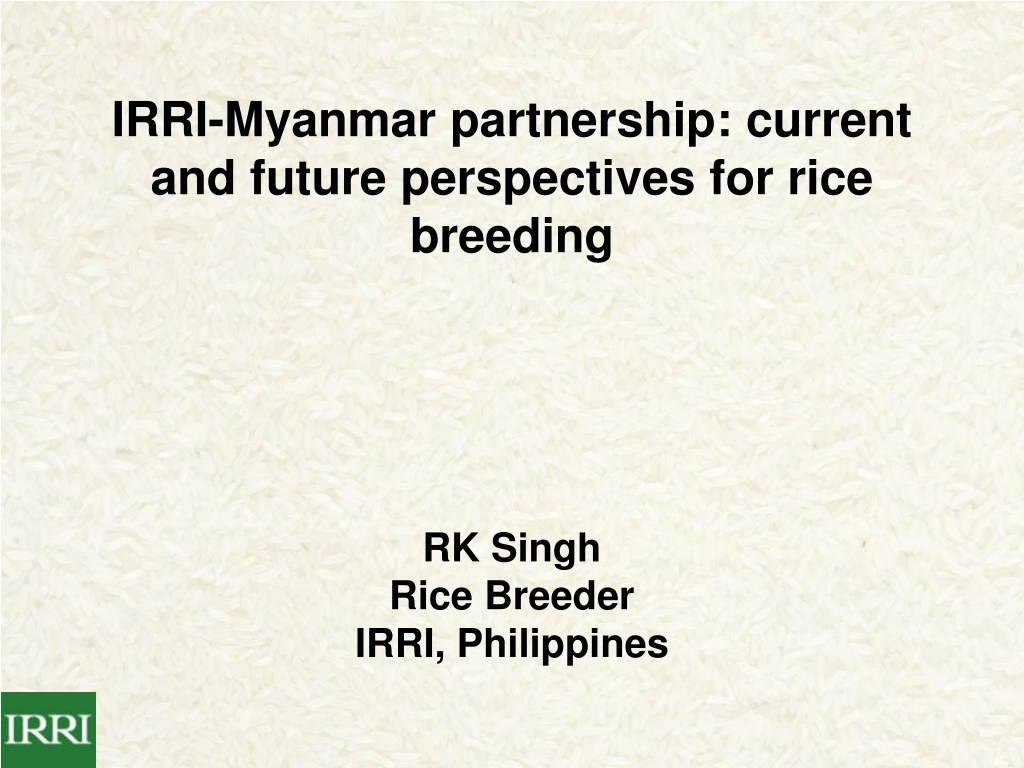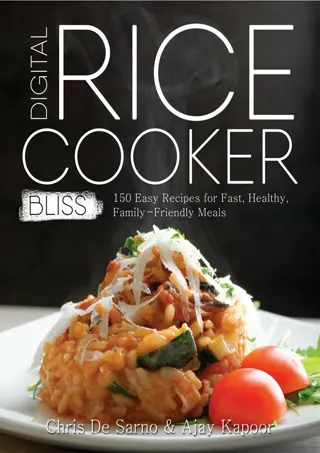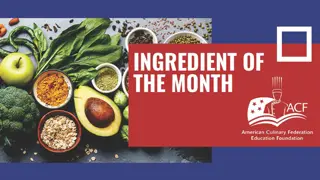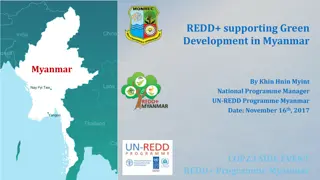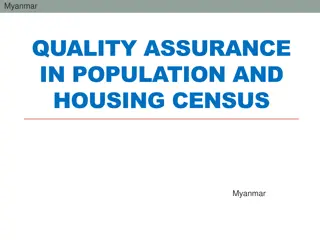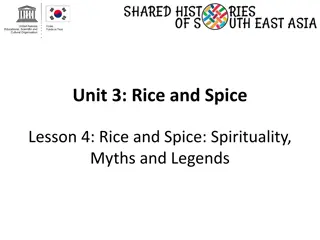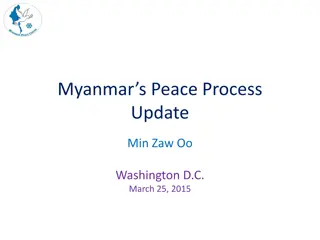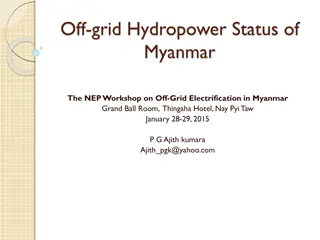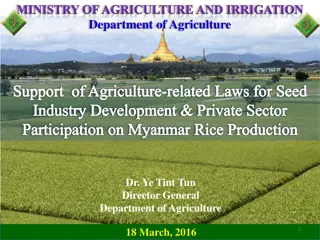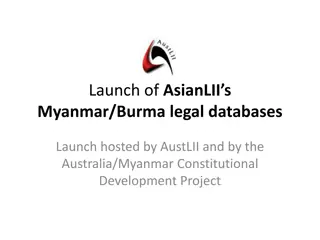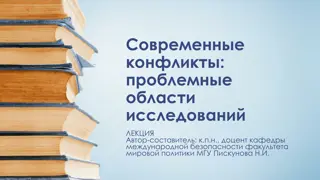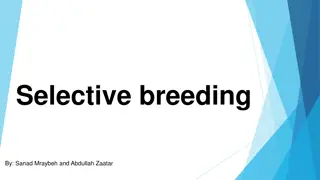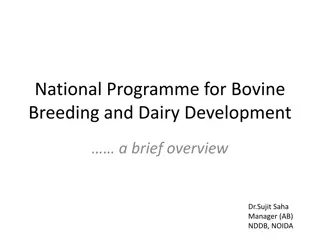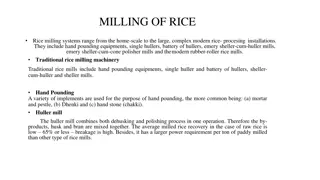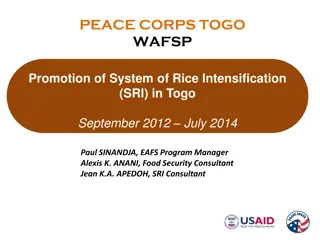Advancing Rice Breeding Partnerships in Myanmar: Current Progress and Future Prospects
The collaborative efforts between IRRI and Myanmar in rice breeding have been fruitful since 1965, with numerous rice varieties released in Myanmar having IRRI lineage. The focus is on developing appropriate rice varieties for different regions to ensure rice yield stability. Target traits for deltaic regions in Southeast Asia include grain yield, quality, flooding and salinity tolerance, stress tolerance, and value addition traits like aromatic grains and AG tolerance. Paw San pearl rice, a unique variety highly regarded in the international market, presents significant potential for further enhancement, particularly in improving plant type and sensitivity to inputs while maintaining grain quality and stress tolerance.
Download Presentation

Please find below an Image/Link to download the presentation.
The content on the website is provided AS IS for your information and personal use only. It may not be sold, licensed, or shared on other websites without obtaining consent from the author. Download presentation by click this link. If you encounter any issues during the download, it is possible that the publisher has removed the file from their server.
E N D
Presentation Transcript
IRRI-Myanmar partnership: current and future perspectives for rice breeding RK Singh Rice Breeder IRRI, Philippines
Partnership in Breeding Since the start of collaboration in 1965 IRRI has contributed a lot for the germplasm development. Max number of rice varieties released in Myanmar has lineage of IRRI Since 2013 onward, about 14 varieties released IRRI role Further Scope: Though Myanmar is not a rice deficient country but rice yield stability in different regions is needed for proper rice distribution. Appropriate rice varieties
RICEPRODUCTPROFILEFORDELTASOF SE ASIA (TARGET REGION) Target Deltaic regions Season - WS Must Traits 1. Grain yield Ayyerwaddy - Myanmar High (>10% Sin Thu Kha or Sin Thew Latt) 2. Grain Quality Inter. AC , GT- Inter; GC >60mm); Chalk <10%; LS-MS 1. Flooding tolerance (Sub1) 2. Stagnant flooding tolerance 3. Salinity tolerance Reproductive stage Bacterial Blight 3a. Stress tolerance (Abiotic) 3b. Stress tolerance (Biotic) Range Traits 1.Duration (days) 135-140 days (Also good to have weak photosensitive varieties) 100-125 2. Plant height (cm) 3. HRR >45% Value Addition (Win traits) 1. AG tolerance 2. Aromatic grains
RICEPRODUCTPROFILEFORDELTASOF SE ASIA (TARGET REGION) Target Deltaic regions Season - DS Must Traits 1. Grain yield Ayyerwaddy - Myanmar High > 5 t/ha 2. Grain Quality Inter. AC , GT- Inter; GC >60mm); Chalk <10%; LS-MS 1. Stagnant flooding tolerance 2. Salinity tolerance throughout 3a. Stress tolerance (Abiotic) 3b. Stress tolerance (Biotic) Range Traits 1.Duration (days) Bacterial Blight and Blast 120-125 days 2. Plant height (cm) 100-110 3. HRR >45% Value Addition (Win traits) 1. AG tolerance 2. Aromatic grains
Paw San Big potential To compete with international market- unique material Paw San pearl rice (best in 2010) is the variety which is widely acclaimed as best bet from Myanmar as exportable rice on premium price Just one event of international rice traders famous - Branding Also has big domestic market Poor plant type, Photosensitive and non-responsive to inputs - IRRI- KIT, Germany - Japan with YAU/DAR Could be improved for plant type and photosensitivity keeping the grain quality intact + abiotic and biotic stresses tolerance
Paw San Pearl rice Raw rice Cooked rice (>2.5 3 times expansion) Strongly aromatic
Clustering of the aromatic rices Source: So et al. 2015. Rice Science 22: 53-64
Healthy rice Micronutrient deficiencies in Myanmar Micro- nutrient % Population group & status indicator Iron 63.2 Preschool-age children with anemia (hemoglobin < 110 g/L) 49.6 Pregnant women with anemia (hemoglobin < 110 g/L) 44.9 Non-pregnant women with anemia (hemoglobin < 120 g/L) Vitamin A 36.7 Preschool-age children vit. A deficiency (serum retinol < 0.70 mol/L) 1.1 Pregnant women with night blindness Zinc 34.6 Population at risk of inadequate intake of zinc Deaths per 100,000 people 20 Stunting by state/region SOURCE: Investing in the future - A united call to action on vitamin and mineral deficiencies. UNICEF, GAIN, MI, USAID, World Bank, FFI; 2009. 18 16 http://www.unitedcalltoaction.org/documents/Investing_in_the_future.pdf - WHO, CDC. Worldwide prevalence of anemia 1995-2005. WHO Global database on anemia. Geneva, World Health Organisation, 2008. 14 - WHO. Global prevalence of vitamin A deficiency in populations at risk 1995-2005. WHO Global database on vitamin A deficiency. Geneva, World Health Organisation, 2009. 12 - WHO Global database on iodine deficiency: http://www.who.int/vmnis/iodine/data/en/index.html, accessed 31 July 2007. 10 - IZiNCG Estimated Risk of Zinc Deficiency, Food and Nutrition Bulletin, vol. 25, no. 1 suppl 2 (2004). 8 LEGEND 6 * Countries with a GDP > US$ 15 000 are assumed to be free of vitamin A deficiency of public health significance. N/A or "-": Data not available. 4 2 Source : M. Swamy 0 Myanmar Source: http://www.worldlifeexpectancy.com/cause-of-death/malnutrition/by-country/ Cambodia Bangladesh India Thailand China
Healthy rice Besides two breeding pipelines, IRRI nutritional quality rice group has finalised the plan to initiate the activities in Myanmar and evaluate the materials from 2016 WS. Healthier is need of the hour in Myanmar (high Fe, high Zn and low GI) but non-transgenic IRRI can immensely contribute to this noble cause
Climate Change Scenario Expected scenarios: Sea level rice, more frequent drought and flooding spells, high day and night time temperature, change in biotic stress pattern. Coastal and dry zones would be more vulnerable IRRI is in better position to develop the suitable climate smart varieties with mitigation techniques (management) Example: Recent release of new stress tolerant varieties
Favourable areas for production boost Irrigated : Need more resources IRRI can partially help with agronomically superior genotypes (inbreds and hybrids through HRDC) DAR Yezin has now become a key location for evaluating yield performance in Myanmar Seed replacement rate very low even in irrigated
Plant Varieties Development Different breeding methods Seed Multiplication Chain Breeder Seed - DAR OYT Yield Trials (at least 3 times) FS DAR /DOA-Seed division Farmers field testing RS Seed farms managed by DAR / DOA Promising entries to Technical sub- committee CS seed village schemes, contract farmers, NGO, private seed company National seed committee (NSC) Government township office, agro-dealers, NGO , millers Nomination new varieties and release Farmers Seed multiplication and distribution > 5 years > 10 years
Myanmar next IRRI-Hub If the HUB country is long latitude wise, we get many different environments Myanmar provides large range of environments. (high variation in rainfall also about 1000 5000 mm) 28 31 N Dry Zone drought and cold Wet Zone High productivity 1009 km Delta zone Flooding, Salinity, two crops 9 32 N
IRRI- Multi-environment trials Yezin has now become a key location for extended rice breeding facility in Myanmar
